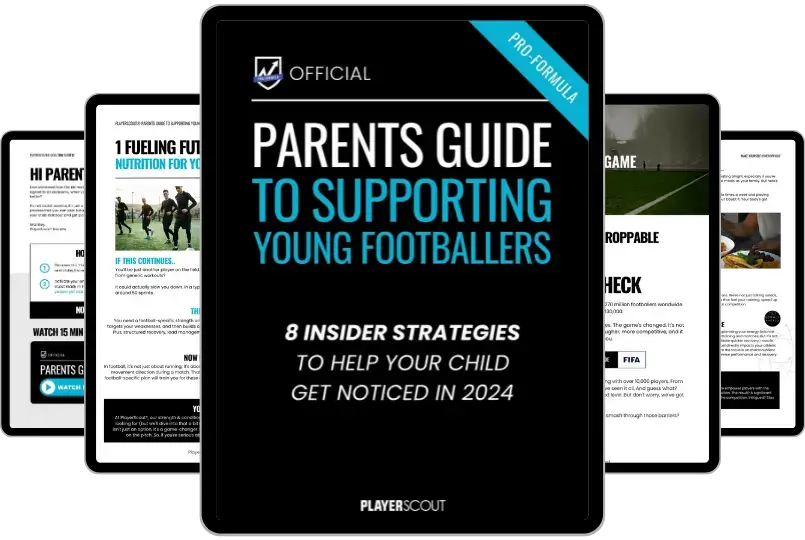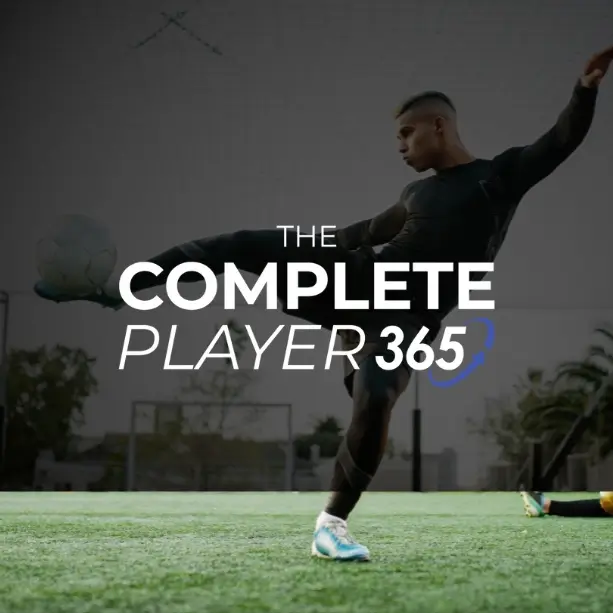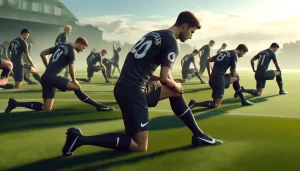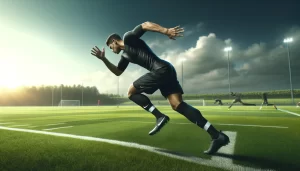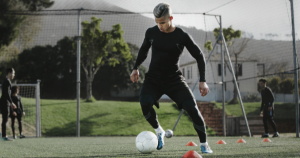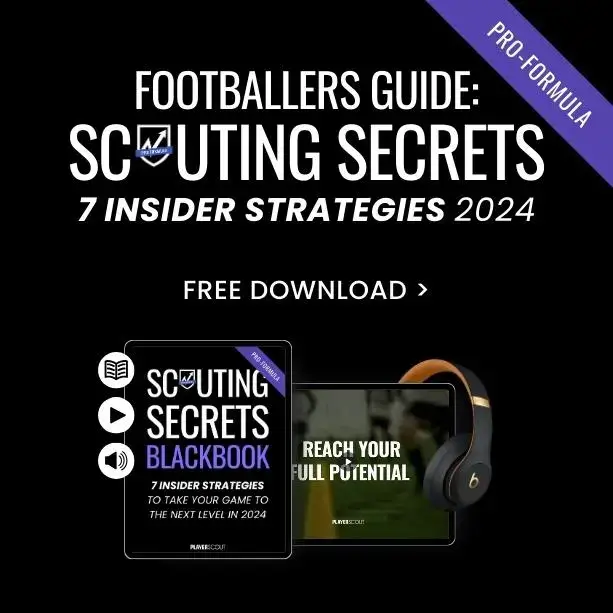Do you have tight quadriceps or aching in the front of your thigh? No need to worry, studies show that a simple routine of foam rolling the quads can relive your pain, improve flexibility and help your performance on the pitch. And the beauty is this can take as little as 2 minutes a day.
The four muscles across the front of the thigh make up the quadriceps or quads for short. These are:
- Rectus Femoris
- Vastus Lateralis
- Vastus Medialis
- Vastus Intermedius
These muscles cover the Femur (thing bone) and are among the most powerful muscles. They are the only muscles that extend the knee and combine with other muscles to bend the knee. The Rectus Femoris muscle is also involved in the hip flexion.
Having strong healthy quads will help you perform explosive movement on the pitch, such as sprint and jumping.
Quad Injuries in Football
An F.A study found that quadriceps injuries were the most common in pre season training. With the Rectus Femoris accounting for 29% of all injuries. This number dropped to 14% of all injuries during the season but shows how important it is to improve the strength and flexibility of the quadriceps muscles.
Cause of Tight Quads
Whether your training in the gym, on the field or playing a match, your quad muscles are sure to work hard. Body weight movements such as jumping, squatting, performing lunges or weighted exercises like leg extension and leg press all target your quad muscles.After excessive work involving the quad muscles, you may feel a spasm like sensation followed by tightness and tension. There are several reasons for this which can be one or a combination of the following:
Why Do Your Quad Muscles Get Tight?
Reason 4
(see Below)
Why Do Your Quad Muscles Get Tight?
Reason 1
(see Below)
Why Do Your Quad Muscles Get Tight?
Reason 2
(see Below)
Why Do Your Quad Muscles Get Tight?
Reason 5
(see Below)
Why Do Your Quad Muscles Get Tight?
Reason 3
(see Below)
Why Do Your Quad Muscles Get Tight?
Reason 6
(see Below)
Dehydration and Electrolytes
A study by the American College of Sports Medicine found that an electrolyte imbalance and dehydration let muscle spasms cramps and tightness. Fluids are important to transports nutrients throughout our bodies and play an essential part in muscle health and function.
92% of your blood plasma comprises water, when these levels are low it causes an electrolytes imbalance in potassium and sodium, whilst also restricting the flow of nutrients and oxygen to the quads.
Restricted blood flow to the quad muscles may cause them to tighten up to hold onto nutrients, resulting in reduced flexibility.
Lack of Warm Up
If you fail to warm up your quad before matches, you are already putting yourself at a disadvantage. Poor or no warm-up means the quads cannot perform their function to the best of their ability and will restrict your movement.
You should do your foam roll routine followed by a static or dynamic warm-up to get your body ready for action. This will help lessen the pain and ache you may feel after training.
Muscle Tissue Swelling
If you have ever experienced quad injury it can lead to swelling in the tissue. The immune system protects the damaged area by flooding it with fluids and nutrients. This may restrict the movement when extending the knee as the quad is filled with fluid.
Quad Muscle Overuse
As with most sports injuries, too much exercise can be detrimental to the muscle. Overusing the quad muscle is one of the main reasons for tight quads.
To build and strengthen muscles (hypertrophy) you need to create tiny micro tears in the muscle. But, when you overtrain a muscle group (such as the quads) the muscle goes into protection mode, by contracting to prevent injury or further damage. Therefore limiting any blood flow to the quad.
Muscular Imbalance
The human muscular skeleton works by oppostie muscles contracting and lengthening simultaneously to move our bodies. The opposite or antagonist muscle of the quadriceps are the hamstrings. When your hamstrings are stronger then the quads this forms an imbalance. Therefore you must strengthen and condition your quad muscles to improve this balance.
Also spending long periods of time sitting or standing with the knees hyperextended can cause the quads to become tight.
Stress and Anxiety
Have you ever tensed up when you’re frightened or stressed? This is due to our bodies fight or flight response to stressful situational. Your adrenal glands release a chemical called adrenaline which tenses muscles in an attempt to protect the body. If you are constantly under stress the body can react in this way more often resulting in a lasting feeling or tightness in your muscles.
How Tight Quads Effect Players
Tight quads can cause all types of problems for players. When a quad is tight it loses its elasticity and puts tension on the joints. If a player’s tight quad muscles is partnered with a weaker hamstring muscle this could result in an injury to the Anterior cruciate ligament (ACL). This BBC Sports article showed the growing trend in ACL injuries in the Premier League. But the tight quad problem doesn’t stop there. As the whole body works like a chain, if you have one weak link it can affect the entire structure, starting with the nearest joint or muscle. As your hip flexors lie next to your quads, a tight or injured quad can pull down on the hip flexor, with dangerous consequences. This causes the hip flexor to tilt the pelvis forward which effects the alignment of your hips, this is known as anterior pelvic tilt (APT). And so begins the domino effect… ATP causes hyper extension at the knees and an increases the curve in your lower back, which put pressure on your vertebrae and can lead to injury in both your knees and your back.So How Can Foam Rolling Help Tight Quads?
Foam rolling has been proven to reduce soreness in muscles for up to three days after exercise. A Macdonald et al. study looked into whether foam rolling could boost recovery and reduce post exercise soreness. After the subjects were put through an intense weight problem designed to fatigue the muscles, the results showed the subjects that use the foam roller had:- A reduction in soreness for up to three days after the fatiguing routine
- An improvement in quadriceps range of motion
- Improved performance in the vertical leap test
Foam Roller Exercises for Quads
For the best results it is best to roll each leg seperately on a high density foam roll. To increase the intensity you can rest your opposite leg ontop of the working leg. The below National Academy Of Sports video, shows how to foam roll the quadriceps.How to Foam Roll your Quads
-
- Lay in a plank position with the foam roller at the top position of your upper leg (just below front of hip). Bend your opposite leg out to the side for support. Throughout the roll you should keep the head, shoulders and back in a neatral position.
- Take a deep breath and roll towards your kneed at a speed of an inch per second. When you find a tight spot, stop and hold for 30 seconds.
- Remember to breathe throughout. Spend 2 minutes on each leg
- If there is pain is two intense, you can role both legs at the same time to spread the weight.
- Repeat for the opposite leg
How Long to Foam Roll Quads
The optimal length of time to foam roll your quads is 2 minutes per leg. If you find a tight spot, hold that position with pressure for 25-30 seconds (should be 7 out 10 in discomfort, but no pain).For Best Results Add Some Stretching
A 2014 study by Mohr et al. found combining foam rolling and static stretching produced even better results.
So perform the following static stretching immediately after you foam rolled the quadriceps. Foam roller quad stretch:
Upper Body Foam Rolling Exercises
- How to foam roll your neck muscles
- How to foam roll your shoulder muscles
- How to foam roll your chest muscles
- How to foam roll your lats
- How to foam roll your rhomboids
- How to foam roll your arm muscles



